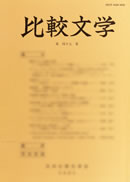Volume 57
Displaying 1-28 of 28 articles from this issue
- |<
- <
- 1
- >
- >|
ARTICLES
-
2014Volume 57 Pages 7-21
Published: March 31, 2014
Released on J-STAGE: May 26, 2018
Download PDF (888K) -
2014Volume 57 Pages 22-36
Published: March 31, 2014
Released on J-STAGE: May 26, 2018
Download PDF (795K) -
2014Volume 57 Pages 37-50
Published: March 31, 2014
Released on J-STAGE: May 26, 2018
Download PDF (848K) -
2014Volume 57 Pages 51-65
Published: March 31, 2014
Released on J-STAGE: May 26, 2018
Download PDF (844K) -
2014Volume 57 Pages 66-79
Published: March 31, 2014
Released on J-STAGE: May 26, 2018
Download PDF (802K) -
2014Volume 57 Pages 80-93
Published: March 31, 2014
Released on J-STAGE: May 26, 2018
Download PDF (774K) -
2014Volume 57 Pages 94-107
Published: March 31, 2014
Released on J-STAGE: May 26, 2018
Download PDF (791K)
-
2014Volume 57 Pages 108-110
Published: March 31, 2014
Released on J-STAGE: May 26, 2018
Download PDF (541K)
-
2014Volume 57 Pages 111-114
Published: March 31, 2014
Released on J-STAGE: May 26, 2018
Download PDF (961K) -
2014Volume 57 Pages 115-119
Published: March 31, 2014
Released on J-STAGE: May 26, 2018
Download PDF (942K) -
2014Volume 57 Pages 120-125
Published: March 31, 2014
Released on J-STAGE: May 26, 2018
Download PDF (976K) -
2014Volume 57 Pages 125-130
Published: March 31, 2014
Released on J-STAGE: May 26, 2018
Download PDF (951K) -
2014Volume 57 Pages 130-134
Published: March 31, 2014
Released on J-STAGE: May 26, 2018
Download PDF (944K) -
2014Volume 57 Pages 134-138
Published: March 31, 2014
Released on J-STAGE: May 26, 2018
Download PDF (970K) -
2014Volume 57 Pages 138-142
Published: March 31, 2014
Released on J-STAGE: May 26, 2018
Download PDF (943K) -
2014Volume 57 Pages 142-146
Published: March 31, 2014
Released on J-STAGE: May 26, 2018
Download PDF (938K) -
2014Volume 57 Pages 146-150
Published: March 31, 2014
Released on J-STAGE: May 26, 2018
Download PDF (939K) -
2014Volume 57 Pages 150-154
Published: March 31, 2014
Released on J-STAGE: May 26, 2018
Download PDF (945K) -
2014Volume 57 Pages 154-158
Published: March 31, 2014
Released on J-STAGE: May 26, 2018
Download PDF (945K) -
2014Volume 57 Pages 158-163
Published: March 31, 2014
Released on J-STAGE: May 26, 2018
Download PDF (950K) -
2014Volume 57 Pages 163-166
Published: March 31, 2014
Released on J-STAGE: May 26, 2018
Download PDF (935K) -
2014Volume 57 Pages 167-170
Published: March 31, 2014
Released on J-STAGE: May 26, 2018
Download PDF (936K) -
2014Volume 57 Pages 171-172
Published: March 31, 2014
Released on J-STAGE: May 26, 2018
Download PDF (916K) -
2014Volume 57 Pages 172-173
Published: March 31, 2014
Released on J-STAGE: May 26, 2018
Download PDF (918K) -
2014Volume 57 Pages 174-176
Published: March 31, 2014
Released on J-STAGE: May 26, 2018
Download PDF (929K)
BOOK REVIEWS
-
2014Volume 57 Pages 235-231
Published: March 31, 2014
Released on J-STAGE: May 26, 2018
Download PDF (720K) -
2014Volume 57 Pages 230-227
Published: March 31, 2014
Released on J-STAGE: May 26, 2018
Download PDF (755K)
-
2014Volume 57 Pages 242-236
Published: March 31, 2014
Released on J-STAGE: May 26, 2018
Download PDF (778K)
- |<
- <
- 1
- >
- >|
